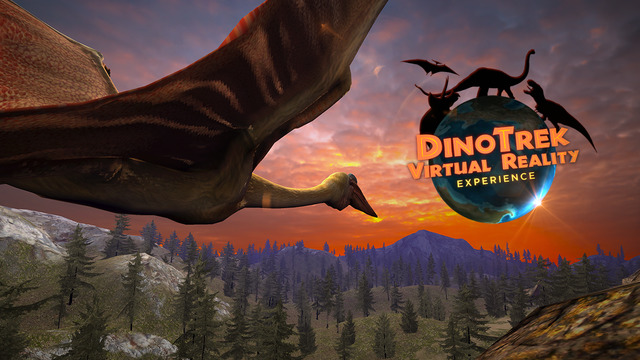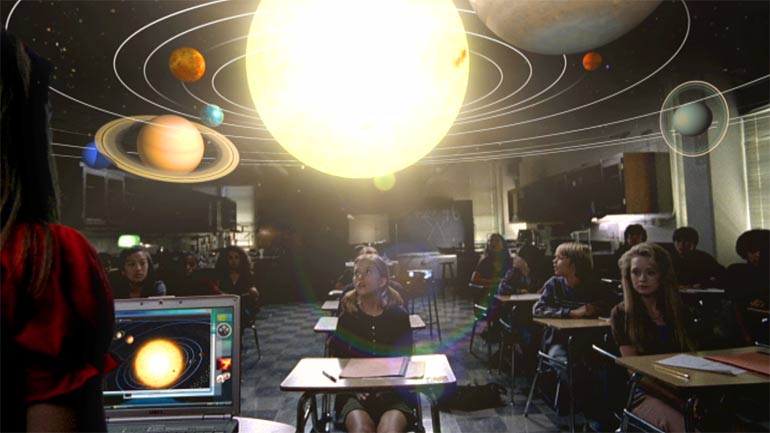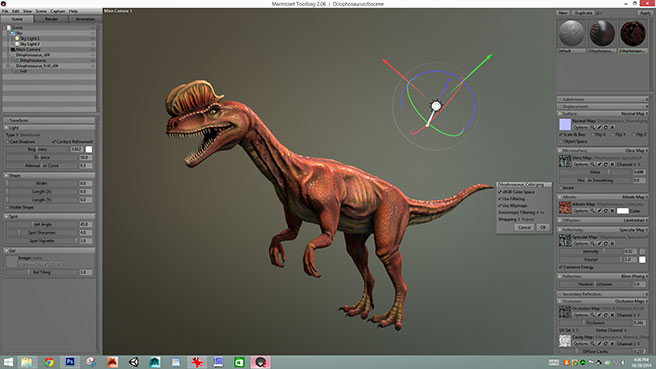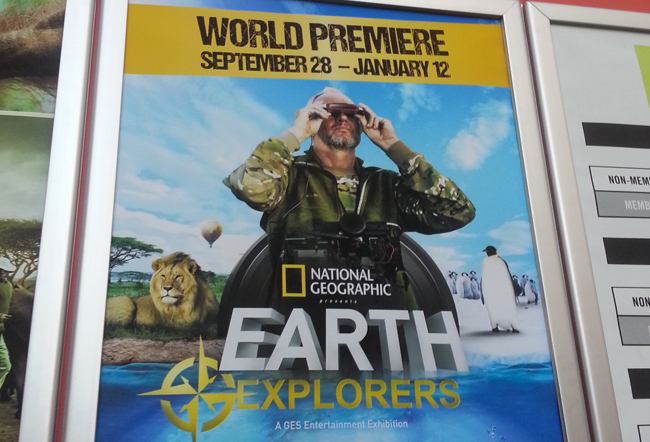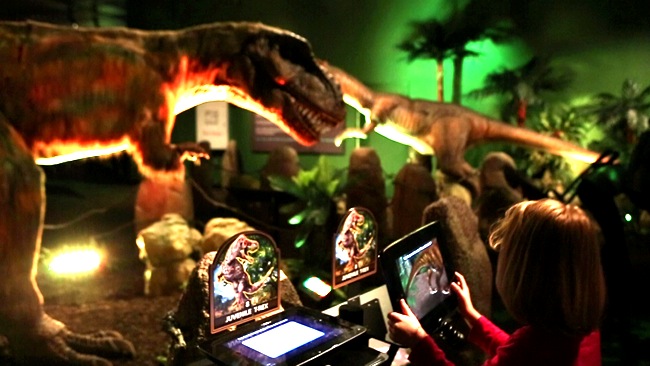Star Spangled Banner “Anthem of Liberty”
With the bicentennial of Francis Scott Key‘s writing of the Star Spangled Banner quickly approaching, we were asked to create over 5 minutes of stereoscopic 4K animation for a documentary telling the story of the lyric inspiring events that led up to that moment… From the march on the young town of Washington to the parting of the morning fog on September 15, 1814 revealing that our flag was still there.

CG Fort McHenry flying the Star Spangled Banner as tall ships sail into Baltimore Harbor.

Wireframe view from Softimage XSI showing extreme close-up detail and texture mapping.
The project posed a number of challenges. First, we needed to upgrade our workstations and rendering pipeline to be able to handle the large stereoscopic IMAX format (12 times the size of HD television!). Second, most of the shots were to be entirely CG so we needed to create content with enough resolution to fill that huge screen while still being realistic, with good detail and perfect stereoscopy.
By now, we’ve all seen movies in stereoscopic 3D and take for granted that the images will create a nice dimensional veiwing experience while being comfortable to watch. For those creating the imagery though, working on a stereoscopic project requires plenty of considerations. There are entire books of jargon dedicated to stereoscopic production and much to keep in mind even for TV sized 3D. When it’s for an IMAX size screen you find yourself starting to crunch numbers to create the right outcome, as monitoring it is impossible without a real theater.

Anaglyph view in Nuke with congreve rockets flying past the camera for stereo effect.
There needs to be a careful balance between screen size, interocular distance, distance from the screen, zero parallax plane, depth budget, field of view, etc. The zero parallax plane (ZPP) is the distance from the 3D camera where the left and right eye images come into alignment. It can be in front of the screen (negative parallax) or behind the screen (positive parallax). If you set this too close to the viewer and they choose to look at distant things in the shot behind the ZPP you may diverge the viewer’s eyes causing an uncomfortable viewing experience. You obviously want to avoid this, which is not so hard to do on a small screen because the divergence can be pretty big percentage-wise and still not exceed the 65mm average interocular distance of an adult. The challenge is that divergence grows with the size of the screen. Because few of us have a 3D IMAX theater tucked behind the break room, and none of us can shrink the distance between our eyeballs we are left doing math and wearing anaglyph glasses to ensure comfortable parallax and a balanced depth budget. This is only the tip of the stereoscopic iceberg, but it gives you a taste of the challenges involved.

Francis Scott Key approaches the British fleet to appeal for the release of Dr William Beanes.
Because there were so few live action backplates, we needed 3D ships, 3D soldiers, 3D water, 3D trees and landscapes… How on earth were we going to do the stereoscopic landscapes at such detail? Immediately, we were thinking matte paintings as backgrounds for several of the shots, but in 3D for stereoscopic. The matte painters employed their talents to make beautiful recreations of the historical settings, sending you back in time with their attention to detail. Because of the large format and the stereo 3D, these matte paintings were huge in resolution and multi-layered. These huge matte images were modeled in 3D so that we could move our virtual stereo cameras around and through them as needed. Then 3D ships, soldiers, buildings, and the rockets red glare were animated around these matte image environments.

Francis Scott Key contemplating our national symbol under the rockets red glare.

Fully CG aerial view of historic Baltimore, Fells Point and the inner harbor.
Not having time to build the British fleet from the ground up, we acquired the best prebuilt 3D ships we could find for the 1812 time period. We remodeled them so they would be detailed enough for the requirements of the shots and to match the appearance notes provided by the historical advisors to the show. The ships were then brought to life in Softimage XSI with windblown sails and rigging, and set on a stage of sculpted waves.

British warship firing congreve rockets during the bombardment of Fort McHenry.

Wireframe view showing rocket trail, smoke particle systems and voxel volumes.
We also built British and US troops with historically accurate uniforms matching their live action counterparts in the show. Modeled, textured and rigged in Autodesk Maya and Mudbox, these troops were used in many of the shots. Troops that required more specific actions were animated individually, other troops were animated to create a library of motions that could then be fed into crowd simulations to produce the hundreds of soldiers some of the shots needed.

Character animation, match move and crowd simulation of British soldiers in Softimage XSI.

CG British troops marching toward Bladensburg.
A couple of the required shots were overhead maps. We were challenged with the task of making 2D maps look good in 3D while telling the story of troop movement and battle progression. Our solution was to create beautifully and highly detailed 2D maps, project them onto three dimensional terrain of the region derived from DEM (digital elevation model) datasets, then add 3D labels, 3D troop regiments, 3D camera moves, and 3D explosions over the battles being featured.

Map of Baltimore and Fort McHenry depicting the position and movement of American and British troops on land and sea.

After defeating the Americans at the Battle of Bladensburg, British troops set fire to many public buildings, including the White House. Recreated here in stereo 3D CGI.
The rendering of all the large format ship, smoke, map, and landscape imagery along with all the render passes required to assemble the final shots were processed by our in-house render farm. The farm contains multiple render nodes consisting of dual 10-core Intel Xeon processors, tons of ram and terabytes of RAID storage all running on a 10 GbE network for a grand total of 240 cores of processing awesomeness! We gave the farm quite a workout but it performed beautifully, running flawlessly and non-stop 24/7 for almost 3 months to complete the project.

British firing congreve rockets from rowboats offshore.
The entire process was done in high dynamic range colorspace, from the matte paintings to the rendering and the composites. This allowed us to make adjustments to the color correction big or small at any stage of the game. In fact, there are a couple of night shots that we can convert to day shots if necessary because of the range of the colorspace. Final compositing, stereo alignment and sweetening was done in Nuke along with After Effects CC for some post processing. Finished shots were delivered as DPX and EXR sequences at 4096 x 3072 left and right eye stereo files.

Nuke flow showing left and right eye composite of 3D render passes.

American troops withstanding the bombardment of Fort McHenry.
In the end, our first venture into the world of 4k Stereoscopic for IMAX was a huge success. We came in on time and buget, we got to make some stunning imagery, the client was happy and we got to wear those crazy 3D glasses!

Top, from left – Jeremy with reenactors, Bayley Silleck, David Clark, Co-Directors, and Don Kempf, Executive Producer. Photos taken by Jim O’Leary. Bottom – Maryland Science Center, Harbor Entrance
The IMAX version premiered at the Maryland Science Center in Baltimore on June 13. Jeremy Kenisky, one of Geomedia’s own was on site for the premiere to do a Q&A with Directors Bayley Silleck and David Clark after the showing. The VFX from the film have received rave reviews, and Geomedia is excited to take this first big step into the 3D Stereoscopic IMAX format!
The television premiere of the Smithsonian Channel program was June 14.
Other venues will follow. This film is distributed by Giant Screen Films.






